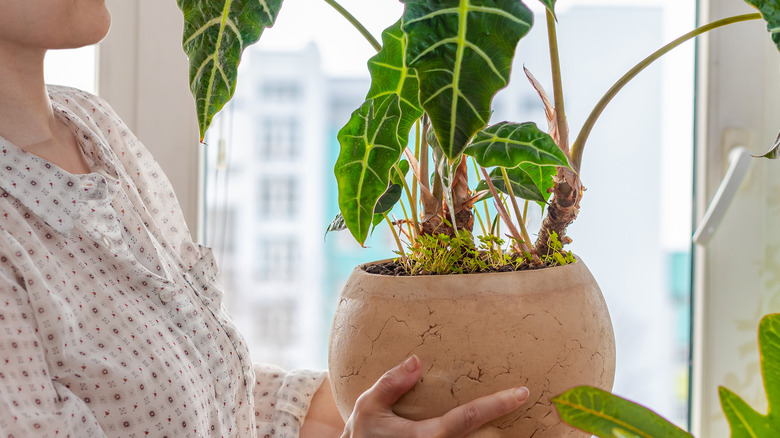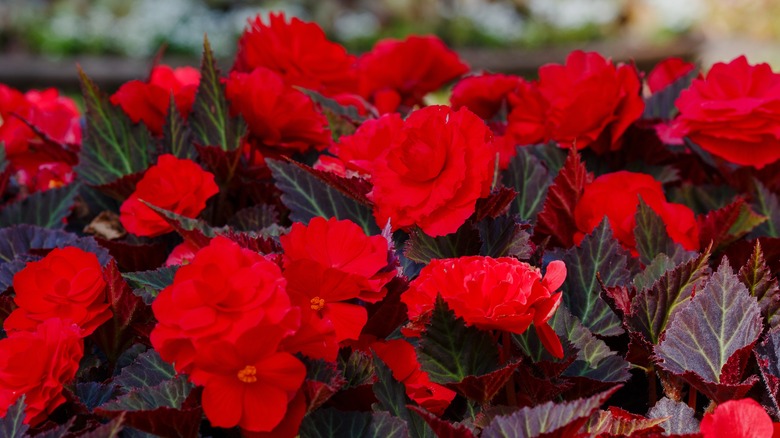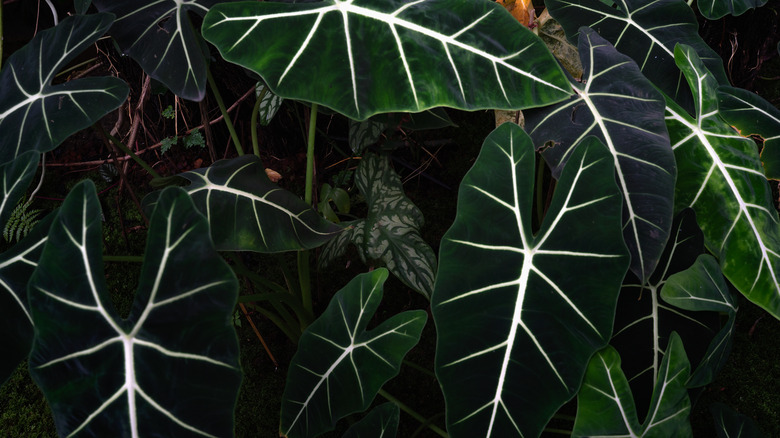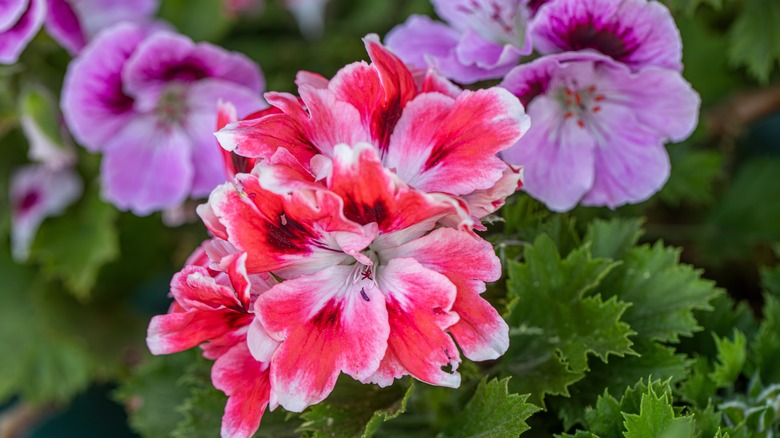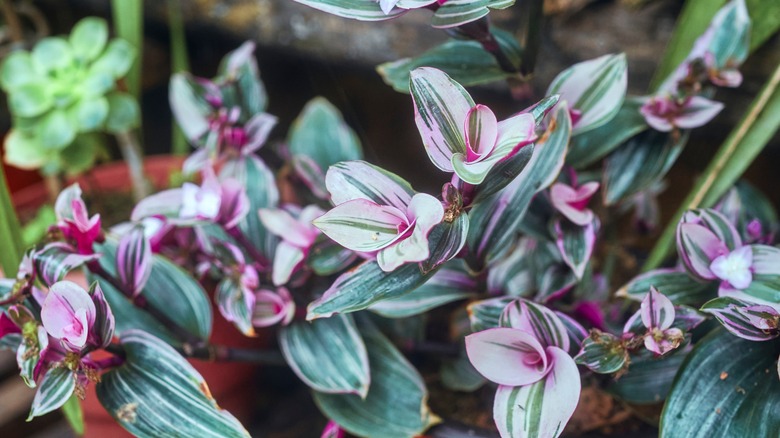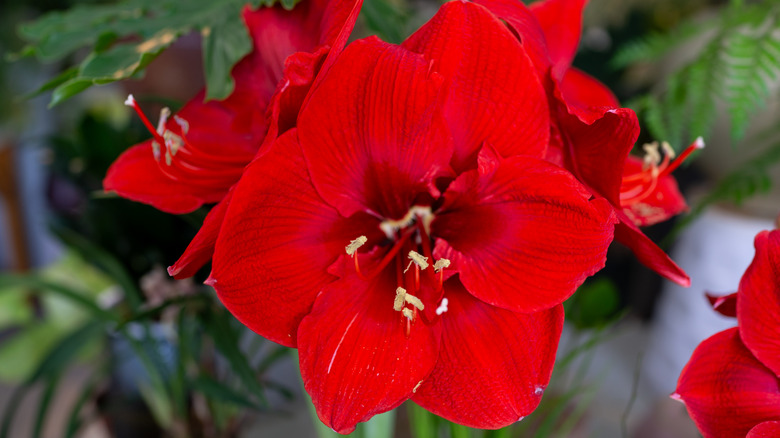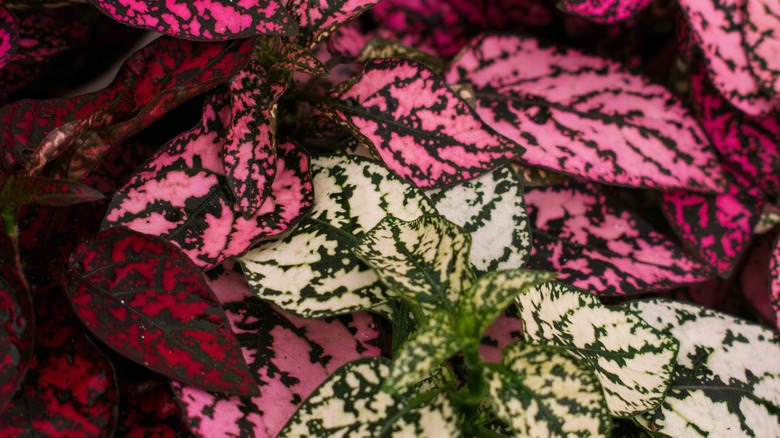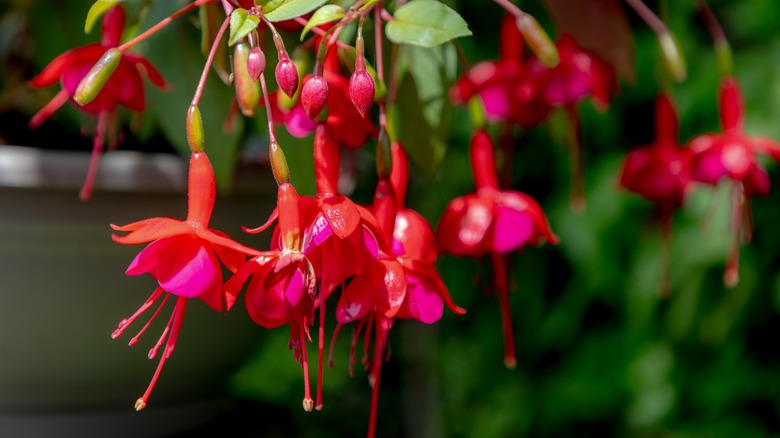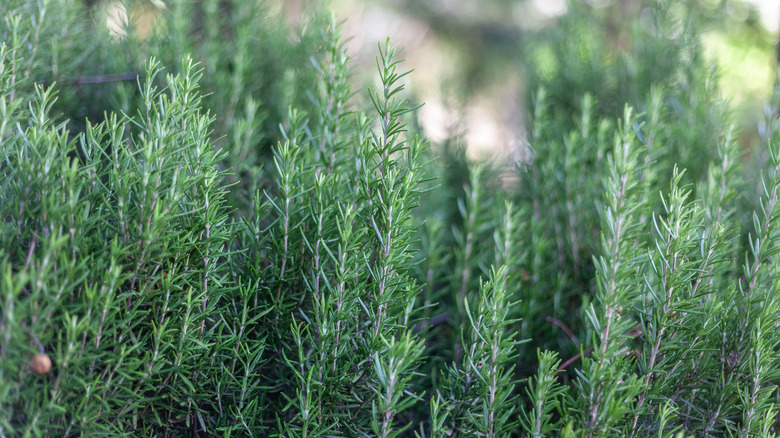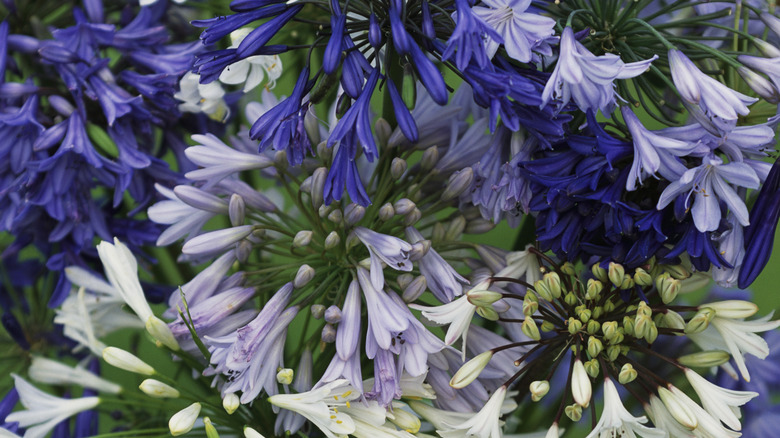9 Common Plants That Should Be Moved Indoors At The End Of Summer
We may receive a commission on purchases made from links.
Annual plants are great for adding color and interest to the garden through the warmer months, but there's something sad and wasteful about the way they die back in fall, never to return again like their perennial relatives. A little-known trick amongst burgeoning gardeners is that actually, many annuals can be saved from the compost heap simply by being brought indoors. If you've taken a particular shine to your new polka dot plants, or you don't want to see your tuberous begonias bite the dust, you can store them in your home and return them to the garden next spring.
From full and flowering fuchsia plants to ripe and aromatic rosemary, there is a wide range of common garden specimens that can be moved indoors at the end of summer instead of being left to wilt and wither. Certain plants are easier to look after through winter than others, so be sure to check the care conditions for each species. Many plants that grow from tubers, corms, or bulbs, can be stored in dark, cool, and dry indoor locations during the colder seasons as they go through dormancy, while some other plants can simply be moved inside the home and treated as houseplants. Here we explore which plants you can shift inside at the end of summer, and how to care for them for the best results.
Save tuberous begonias for next season by storing the tubers indoors
Tuberous begonias produce pretty, almost rose-like blooms that come in a wide range of colors to add beauty and interest to the garden. As their name implies, they are grown from tubers, which are similar to bulbs or corms. They are grown as annuals and typically discarded after they have finished flowering at the end of summer. They cannot tolerate freezing temperatures, so in any climate where frost is experienced, tubers left in the ground will die. However, you can save the begonias by storing the tubers indoors. Next spring, they can be planted outside and will flourish again for the growing season.
To save your tuberous begonias for the following year, dig them up before the first frost occurs. Trim back the green growth, leaving the roots and soil as untouched as possible. Move the plants to a cool and dry area in the home like an attic or basement, allowing them to cure for a handful of weeks. Next, brush away all the soil and trim back any roots so you only have the tuber remaining. This is crucial because it helps to prevent rot from developing and reaching the tuber. Store the tubers in a dark, dry, cool (but not freezing) spot like a closet or garage until next spring. If you're worried they will get too cold, you can also nestle the tubers in an insulating layer of dry coco peat, peat moss, sand, or wood shavings. They can be replanted once warmer weather returns, in moist soil, and in a position of partial sun and shade.
Elephant's ear plants can be stored or enjoyed indoors until next spring
Elephant's ear plants are thus called due to their oversized heart-shaped foliage that resembles the large mammal's lugs. They encompass a number of species including Alocasia, Xanthosoma, and Colocasia. These striking leafy plants are hardy through USDA hardiness zones 8 to 11, where they can be grown all year round. However, in cooler climates, they are more commonly kept as annuals. If you want to save your elephant's ear plants from dying at the first sign of frost, you can move them indoors where they can be stored or enjoyed until the weather warms up again.
The type of elephant's ear plant you have will determine what you need to do to overwinter it. If the plant is growing from corms or tubers then you'll need to dry them out for a couple of weeks and store in a cool, dark, and dry spot through winter. For elephant ears that grow from roots, simply moving the specimen indoors to be appreciated as a houseplant in cooler months is the best option. When nighttime temperatures dip to below 45 degrees Fahrenheit, set them up in a warm and bright room where they will receive plenty of natural light. If you already know how to successfully care for elephant ear plants you'll be used to maintaining moist soil in their pots, but through winter the plants will become semi-dormant, so their watering needs will be greatly reduced. Aim to top up the water occasionally to prevent the soil from completely drying out. When spring arrives and the chances of frost have passed, the plant can be returned outdoors.
Enjoy geraniums as houseplants through the cooler months
If you live in USDA hardiness zones 9 to 12 then your geraniums can remain outdoors all year round as perennials, but anyone gardening in cooler zones will likely be growing geraniums as annual flowering plants. A great tip for geranium fans is to bring your bright blossoms indoors through the winter months and keep them as houseplants. They enjoy the typical temperatures that homes provide and will continue to grow with minimal care, making them a great low-maintenance choice for busy people.
To overwinter your geraniums, you'll need to dig the plants out of the soil and repot them in containers to be brought indoors. Alternatively, you can grow happy and healthy geraniums in containers all year round, which will save you from having to dig up and re-plant them each season. Once inside, position your geraniums in a bright window and aim to only water them once the top few inches of soil have dried out. When spring arrives, you'll need to significantly prune the plant to remove any leggy growth and encourage new shoots to appear. Snip back the stems by one-third to one-half their length, and resume usual care. By May, your geraniums should be showing signs of revival and can be moved outside once more.
Spiderwort plants won't survive outdoors in cold winter climates
Spiderwort plants, also known as Tradescantia, are native to warm climates like Guatemala and Mexico. As such, they can survive as perennials in USDA hardiness zones 9 to 11, but outside of these zones, you'll need to grow outdoor spiderwort plants as annuals. Or, if you don't want to start over with these trailing beauties every spring, you can welcome them into your home as houseplants each fall and winter. The interesting foliage of the spiderwort has led to a rise in popularity of the species being used as indoor décor, and interestingly the easy-to-grow plant could also help freshen the air in your home.
Spiderworts perform best in shady conditions when grown outside, but it's important to note that when kept indoors they will need a higher level of light to survive. Set the plant near a bright window or beneath a grow light such as this one from Amazon, and maintain moist soil. Spiderwort specimens are widely kept as houseplants all year round, so they will usually adapt very well to life indoors, and, incidentally, will look stunning trailing from a bookcase or windowsill. You can return the spiderwort to the garden in the spring after the final frost.
Amaryllis plants don't need to be treated as annuals
These beautiful flowering plants are often grown as annuals, but you can easily save your amaryllis bulbs for more gorgeous blooms next season. In fact, amaryllis bulbs have been said to continue producing show-stopping blooms for as long as 75 years, so there's no need to give up on these plants after just one season. The bulbs won't survive outdoors through winter in climates that experience frost, but you can bring them into your home and keep them in active growth, which will in turn allow them to bloom again next year. One thing to bear in mind before you welcome these bright blooms into your house is that they aren't the best choice for everyone. You may want to think twice before growing amaryllis indoors if you have pets or young children who might explore with their mouths, because all parts of this plant are extremely toxic.
To give your amaryllis the best chance of reblooming, move it indoors before the first frost of fall, and set it in a bright location. Cut the flowers off the plant as soon as they are spent. If you don't, the plant will direct its energy towards producing seeds instead of saving resources for making more flowers. Leave the flower stalks and leaves intact until they have faded to yellow, at which point, they can also be removed. Water the plant through winter, and in the spring, gradually move it back outdoors. It will need to acclimatize to life outside, so start by positioning the plant in the shade and slowly return it to a sunny spot.
Bring polka dot plants indoors for additional color in the winter home
Polka dot plants have long been thought of as houseplants, but these Madagascar natives have more recently been gaining popularity as dainty annuals in the garden. They can survive outdoors year-round through USDA hardiness zones 10 and 11, but outside of these hot climates, they will either die back or need to be brought indoors for overwintering. As polka dot plants make great houseguests, it makes sense to welcome them into your home and enjoy them through the colder months.
For the sake of convenience, you could grow polka dot plants in containers in your yard. This makes them more portable so you can easily move them to an indoor location at the end of summer. If your polka dot plants are growing in the ground, you'll need to dig them up and repot them in containers to be kept inside through winter. In the garden, polka dot plants enjoy semi-shade, but as houseplants, they will perform better in bright light. They thrive in humidity, so a spot in the bathroom or a terrarium can work really well. Once spring rolls around again, you can return your polka dot plants to the yard.
Don't discard your fuchsias in the fall
Fuchsias are one of the most popular flowering plants for hanging baskets because they produce masses of blooms for a full and lush look, and they come in a huge range of vibrant colors. One key thing to know about fuchsia plants is that they don't need to be thrown out once the flowers have faded at the end of summer. You can bring your fuchsias indoors before the first frost and keep them growing until next season when they can be returned outdoors.
Before bringing your fuchsia plant indoors, thoroughly inspect it for insects. As these plants have a dense growth habit, it can be easy for infestations to go unnoticed, and you don't want to bring the problem into your home where it could spread to houseplants. If your plant has grown large and unmanageable over the summer, cut it back before bringing it indoors. A cool, low-lit spot will be the best place for your fuchsia to spend the winter, so consider settling it in a spare bedroom at the back of the house, or even a basement. A temperature range of between 40 and 50 degrees Fahrenheit will be ideal. To successfully care for your fuchsia plants indoors, water them occasionally, and otherwise forget about them. In March, give your fuchsias a generous watering and a heavy prune, then move them to a brighter indoor location. Over the next two months, continue to feed and water the plants regularly, before positioning them back outside in May.
Overwinter your rosemary indoors in a cool but bright location
Rosemary is a popular plant for both its aesthetic advantages and its status as a delicious herb. It is winter hardy down to USDA zone 7, and while it may handle an occasional frost, as a Mediterranean herb it's simply not built for harsh winters, and sustained temperatures much below 30 degrees Fahrenheit can lead to premature death. To save your rosemary from an early demise, move it into your home through winter. The added bonus of welcoming rosemary into your living quarters is that this herb also works as a natural pest repellent for many common creepy crawlies because it emits such a strong aroma. In fact, you can experiment with keeping this herb in the house to ward off pesky cockroaches and it may even help to keep ants out of your kitchen.
Rosemary should be moved indoors before the first frost. Ideally, grow it in a container in your garden so that it can be easily shifted inside. Because it hails from the Med, rosemary thrives in very bright conditions but isn't well adapted to growing in dry and hot climates through winter. While you should aim to position your rosemary in a very sunny spot, it will perform best in a room that doesn't have the indoor heating set too high. A temperature range of 50 to 60 degrees Fahrenheit is ideal, so consider a bright spot in an unheated porch or a basement with a window. If you don't have a suitable spot to overwinter your rosemary, put it in an unused room and set it beneath a grow light.
Grow Agapanthus as houseplants through winter
Agapanthus is a genus encompassing six main species that are more commonly known as 'lily of the Nile' or 'African lily', despite not being related to the lily family at all. These plants grow from rhizomes and are predominantly evergreen types that can be grown year-round in USDA hardiness zones 8 and upwards. If you live in zone 7 or lower, you don't need to allow these plants to die back over winter. Instead, bring them indoors and treat them as houseplants. Evergreen Agapanthus plants will remain attractive all year round, so you can continue to enjoy their beauty in your home throughout fall and winter.
When growing Agapanthus outside, plant them in pots so they can be easily carried indoors in the cooler months. These plants are known to bloom more profusely when they are root-bound, so keeping them in containers also makes sense for a more impressive floral display. Agapanthus will fare well in typical indoor temperatures, but they need lots of bright light so be sure to position them close to a window. If you have deciduous Agapanthus plants in the garden, these can also be moved indoors throughout fall and winter, and stored in a cool and dark space such as a basement. Return plants outdoors the following spring.
